The last full day of ICCF-18’s Blizzard in July!
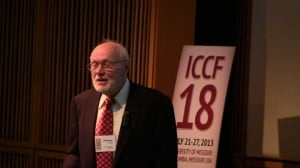 Thomas Passell presented Evidence for Oppenheimer-Phillips Reactions in Deuterated Palladium and Titanium, in this case, about deuteron stripping reactions. Passell was at the Electric Power Research Institute (EPRI) when the announcement came out in 1989, and recommended funding for SRI International to research the phenomenon. EPRI was confused by the rushed 1989 DoE report concluding there was nothing to the Fleischmann-Pons Effect (FPE). When the Bhabha Atomic Research (BARC) published their results of multiple tests by 12 groups showing nuclear effects, EPRI then proceeded with funding, and continued for years.
Thomas Passell presented Evidence for Oppenheimer-Phillips Reactions in Deuterated Palladium and Titanium, in this case, about deuteron stripping reactions. Passell was at the Electric Power Research Institute (EPRI) when the announcement came out in 1989, and recommended funding for SRI International to research the phenomenon. EPRI was confused by the rushed 1989 DoE report concluding there was nothing to the Fleischmann-Pons Effect (FPE). When the Bhabha Atomic Research (BARC) published their results of multiple tests by 12 groups showing nuclear effects, EPRI then proceeded with funding, and continued for years.
He claims that deuterons must prefer to react with stationary atoms in the metal host, rather than other moving deuterons, and apparently, “109 and 88 are the magic numbers” for Passell.
A series of theoretical lectures followed.
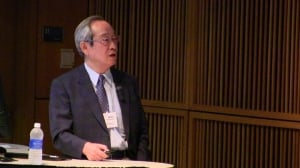 Akito Takahashi was first with Nuclear Products of Cold Fusion by TSC Theory, work sponsored by Technova, Inc.
Akito Takahashi was first with Nuclear Products of Cold Fusion by TSC Theory, work sponsored by Technova, Inc.
He asked first why there is so little radiation from cold fusion? He then compared experimental claims with the predictions of his TSC model.
24 +/-1 MeV/He4 heat, weak alpha peaks, and weak neutrons – all seen in Pd-D systems – were close to what his model predicted. Heat with no neutrons or gammas was close to what he expected theoretically in Ni-H systems. The lack of nuclear ash data is an unknown for this comparison, though.
Takahashi sees three distinct states, an initial state where a unique structure forms, an intermediate virtual state, and a final state interaction. The TSC is the unique formation of a Tetrahedral Symmetric Cluster of four deuterons, which then fuse to Be8 before fissioning to alpha particles.
Takahashi indicated that his TSC model could explain Alexander Karabut‘s data, the very same that Peter Hagelstein explained yesterday with his new idea.
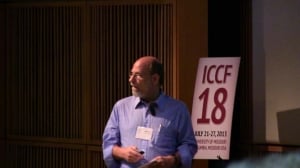 Another theoretical model was presented by Andrew Meulenberg with Composite Model for LENR in Linear Defects of a Lattice. Meulenberg summoned Schwinger’s model to begin, acknowledging Edmund Storms’ new model, which has inspired to Meulenberg to think along new lines.
Another theoretical model was presented by Andrew Meulenberg with Composite Model for LENR in Linear Defects of a Lattice. Meulenberg summoned Schwinger’s model to begin, acknowledging Edmund Storms’ new model, which has inspired to Meulenberg to think along new lines.
Julian Schwinger spoke about a correlated phonon-induced motion of a D sub-lattice. How does phonon emission alter hydron motion? An increased number of phonons implies more amplitude of motion, and high phonon emission gives local concentration above the norn.
But how do you overcome the D-D Coulomb barrier? Sinha’s model of 1999 speculated that pair up bound electrons, allowing D+ and D- to attract. Electron pairing is well-known phenomenon and pairing in an s-orbit (at multi-eV levels) is stable. M noted that this doesn’t work inside the lattice, but a linear defect allows it.
Linear defects also allow phonons to bring deuterons closer together. Linear defects allow hydrogen ground state to drop deeper down, become important.
Meulenberg showed Sinha’s Hamiltonian, somewhat similar to Hagelstein’s yesterday.
 If deuteron separation is at 1500 Fermi, dimensions are shrinking to a 1-d situation, and the electron spends more time in between. High electron density can be maintained with a chain of hydrons, forming kilovolt electron wells, building up enough negative charge, creating a way around the Coulomb barrier.
If deuteron separation is at 1500 Fermi, dimensions are shrinking to a 1-d situation, and the electron spends more time in between. High electron density can be maintained with a chain of hydrons, forming kilovolt electron wells, building up enough negative charge, creating a way around the Coulomb barrier.
Variable lattice space allow linear space to bring multiple H or D, giving “alot to play with.”
Says Muelenberg, “Different models for CF are converging to a coherent picture; fitting the data without violating any physics and chemistry principles.”
Storms commented during M’s question period, thanking him for putting his idea into context and providing the vocabulary of physics. He then quipped to all his colleagues, “I don’t care if you believe my theory or not, just don’t believe anybody else!”
 Theoretical Analysis and Reaction Mechanisms for Experimental Results of Hydrogen-Nickel Systems presented by Yeong Kim was anticipated because of his recent collaboration with Defkalion Green Technologies, who beamed in a video of their demonstration of the R-5 reactor in Milan on Tuesday.
Theoretical Analysis and Reaction Mechanisms for Experimental Results of Hydrogen-Nickel Systems presented by Yeong Kim was anticipated because of his recent collaboration with Defkalion Green Technologies, who beamed in a video of their demonstration of the R-5 reactor in Milan on Tuesday.
The Hyperion reactor contains a core of nickel metal foam. Heating the system to 180 C – 849 C, the Hyperion is then triggered, after which the magnetic field rose 0.6 to 1.6 Tesla.
Kim says, “This indicates that LENRs are producing very strong electric fields E, currents I, and magnetic fields B.”
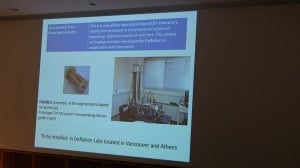 Kim reported Defkalion tests produced excess heat only with the even isotopes of Ni (58, 60, 62, and 64), whereas odd isotopes do not produce excess heat (61).
Kim reported Defkalion tests produced excess heat only with the even isotopes of Ni (58, 60, 62, and 64), whereas odd isotopes do not produce excess heat (61).
No gammas outside of 50 keV to 300 keV were detected from the Hyperion.
Graphs were shown of an excess heat run, and a control run, where the data showed the power can be cut-off at will, revealing the ability to control the reaction.
Kim then began to describe his theoretical explanation of the data. He speculated that in the Fleischmann-Pons Effect (FPE), two deuterons making a Helium-4 require a symmetric release of energy, to conserve total momentum.
For two-particles exiting the reaction, his model shows lower probability.
“The problem is solved”, says Kim, and he is willing to talk to other theorists to help convince them.
He then described Boson Cluster-State Nuclear Fusion (BCSNF) generalized to include Hydrogen-Metal Systems. While there are still some unknowns, namely the S-factor representing the nuclear force strength, and the probability of the Boson Cluster State (BCS), the predicted reaction rates can be compared with the experimental reaction rates.
Kim speculated that the magnetic fields generated by the triggering could provide magnetic alignments of Nickel atoms, and these could provide localized magnetic trap (LMT) potentials for Boson clusters on the surface of Ni powders, though these traps have short lifetimes.
It is Rydberg atoms that then form the BEC cluster state.
“H and Ni powders triggered by glow discharge created a magnetic field causing Rydberg states allowing nano-scale localized magnetic traps, allowing Hydrogen Boson Cluster States in the LMT on the Ni surfaces. Fusion between these elements create excess heat and locally produced glow discharges.”
Kim writes, “Transmutation reactions involving Ni isotopes may not be dominant reaction mechanism but could be part of much weaker secondary reaction.”
Kim believes that self-sustaining reactions could be improved by increasing the deuterium density, and this will be tested with Hyperion R-6 reactor with the on-line real-time mass spectrometer at Defkalion Lab.
1% of Defkalion revenue will be spent on basic scientific research. Moving forward, Defkalion will be cooperating with National Instruments, as well.
A short break allowed me to take a few photographs, and before I knew it, I heard Vladimir Vysotskii‘s voice echoing through the hall. I knew I was late for the Transmutations in Biological and Chemical Systems Panel
Jean-Paul Biberian, the Chair of the panel had opened up the session, handing it off to Vysotskii, who has done some stunning work in transmutation of elements in a heavy-water solution with added micro-organisms, whereby the culture “absorbs” the element, and then transmutes it to a new element. Vysotskii’s research is attempting to use this process to transmute radioactive Cesium-137 to a benign material, offering a path to ridding the planet of 100,000 tons of spent reactor fuel, a high-level radioactive waste, as well as the 1 million tons of highly active water in the world, and the 10 million tons of low-level radioactive waste.
The method is being tested at the Chernobyl region, and he will be working with engineers at the Fukushima plant to further test the application.
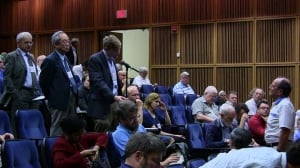 Vysotskii was clear to say that it was not just accelerated decay, but a reduction in the number of active atomic elements – a change of 24% in one run. He noted that in the Chernobyl region, there has been an abnormal accelerated decrease of environmental radioactivity, implying that it may be related to the transmutation of these elements by biological organisms.
Vysotskii was clear to say that it was not just accelerated decay, but a reduction in the number of active atomic elements – a change of 24% in one run. He noted that in the Chernobyl region, there has been an abnormal accelerated decrease of environmental radioactivity, implying that it may be related to the transmutation of these elements by biological organisms.
Lectures were almost an hour behind schedule now. Vysotskii took a few queries, laughing that no matter what, “I have an answer to every question!”
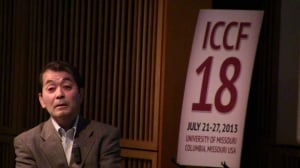 Akira Kitamura, sponsored by Technova, Inc, began his talk on A Mass-Flow-Calorimetry System for Scaled-up Experiments on Anomalous Heat Evolution at Elevated Temperatures. He described a new cell that uses oil-mass-flow calorimetry and where coolant controls the temperature within 0.1 degree C. Neutron and gamma detectors are situated around the vacuum-chamber, sealed unit.
Akira Kitamura, sponsored by Technova, Inc, began his talk on A Mass-Flow-Calorimetry System for Scaled-up Experiments on Anomalous Heat Evolution at Elevated Temperatures. He described a new cell that uses oil-mass-flow calorimetry and where coolant controls the temperature within 0.1 degree C. Neutron and gamma detectors are situated around the vacuum-chamber, sealed unit.
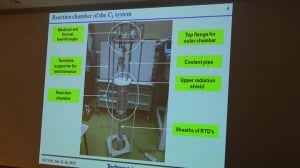 Al2O3 powder was used as a control to calibrate. Preliminary runs used CNS/Al2O3 sample, where the Silica compound was made with a nickel and copper nano-compound containing 4 grams nickel mixed with 200 grams Al2O3 . Temperature output varies with heat input in both cases.
Al2O3 powder was used as a control to calibrate. Preliminary runs used CNS/Al2O3 sample, where the Silica compound was made with a nickel and copper nano-compound containing 4 grams nickel mixed with 200 grams Al2O3 . Temperature output varies with heat input in both cases.
The coolant oil reached almost 300 degrees C at heater input of 231 W. There was long-term stability. The trial run excess heat appeared to be on the same order as that of the CNZ sample yielding about 2W/g-Ni.
The talk on ENEA Workshop Comments and Next Steps by Vittorio Violante was rescheduled due to time constraints.
After lunch, it was time for the Neutron and Radiation Production Panel chaired by Xing Zhong Li. John Gahl, Frank Gordon, Graham Hubler, and Thomas Passell were panel members.
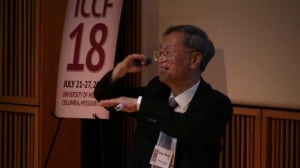 Xing Zhong Li spoke first about an early effort to detect neutrons from inside a neutrino detector in order to test the nuclear origin of the Fleischmann-Pons Effect (FPE), (a big mistake). In any rate, neutrino detectors are no long giant caverns of technology, but smaller 3x3x3 cubic meter units.
Xing Zhong Li spoke first about an early effort to detect neutrons from inside a neutrino detector in order to test the nuclear origin of the Fleischmann-Pons Effect (FPE), (a big mistake). In any rate, neutrino detectors are no long giant caverns of technology, but smaller 3x3x3 cubic meter units.
Li feels we should be testing cold fusion cells for neutrinos (using one of these smaller units), and asked the auditorium if anyone knows anyone who can help obtain one. And that was all he wanted to say.
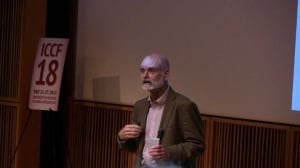 John Gaul uses the MURR cyclotron to shoot 8.4 MeV =/- 2.3% deuterons at deuterium-loaded palladium foil, and found higher levels of Pd109 afterwards, as well as Pd-111 and Ag-111. The foils were hot, too. Experimental cross-sections were much larger than expected.
John Gaul uses the MURR cyclotron to shoot 8.4 MeV =/- 2.3% deuterons at deuterium-loaded palladium foil, and found higher levels of Pd109 afterwards, as well as Pd-111 and Ag-111. The foils were hot, too. Experimental cross-sections were much larger than expected.
These were the results of only two experiments, and uncertainties like beam current on the target, will need further runs, which are planned.
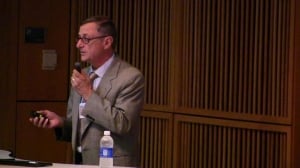 New SKINR Director Graham Hubler presented Unusual Nuclear Isomer
New SKINR Director Graham Hubler presented Unusual Nuclear Isomer
180Tam
229Thm 7.6 eV nuclear excited state 5 hour lifetime
Hubler asks: Can isomers like this play a role in anomalous heat? Are there any more undiscovered low energy isomers? Nuclear structure theory is too inaccurate to predict others.
Low-energy nuclear work was dropped prior to 1940 until the early 50s. It is just now picking up again. He talked about the nuclear Halo effect, and enhanced low energy cross-sections for d,d and d,p which show anomalies, and 3-d fusion. I can’t say I understand this, so forgive me if I end there.
Hubler ended with, “Not all the nuclear structure is known, and there’s probably more to find.”
 Frank Gordon began his talk Bottom Line Up Front, and his bottom line? Radiation is produced in LENR experiments, but much, much lower than what is expected by conventional theory. He showed a graph summarizing just some of the reported radiation and how it was measured. His work in San Diego detected triple tracks in CR-39, indicating the presence of energetic (>9.6 MeV) neutrons, though seven orders of magnitude below the expected number expected by conventional theory and hot fusion. “Low flux rates suggest new/unidentified channels including possibly aneutronic reactions exist.”
Frank Gordon began his talk Bottom Line Up Front, and his bottom line? Radiation is produced in LENR experiments, but much, much lower than what is expected by conventional theory. He showed a graph summarizing just some of the reported radiation and how it was measured. His work in San Diego detected triple tracks in CR-39, indicating the presence of energetic (>9.6 MeV) neutrons, though seven orders of magnitude below the expected number expected by conventional theory and hot fusion. “Low flux rates suggest new/unidentified channels including possibly aneutronic reactions exist.”
He showed some pictures of those tracks next to DT neutrons, almost identical. “Experiments provide compelling evidence that nuclear reactions are occurring”, says Gordon, who no longer says “irrefutable evidence”, because “you can refute anything”, and apparently people who do so.
Tom Passell was back with Evidence for Deuteron Stripping in Metals That Absorb Hydrogen to show slides he hadn’t shown before. Passell has a hundred glow-discharge cells running 24-7 at 2 Watts each, all with different metallic cathodes. 40 kHz AC and low power, they live for a months at a time.
That was all I was able to get of this talk.
At 3PM, David French led a seminar on patents. He spoke of the general features a good patent should have to receive approval, focusing on the particulars relating to cold fusion. French is well-versed in the history of technology and uses many examples to illustrate complex issues using easy-to-understand analogies.
He took many questions from audience in rapid-fire, answering general and specific issues that the participants had brought up. French wants to help cold fusion scientists make better patents to get new energy technology officially approved.
Unfortunately, I must apologize for missing Hydrogen Embrittlement and Piezonuclear Reactions in Electrolysis Experiments by Alberto Carpinteri and Piezonuclear Fission Reactions Simulated by the Lattice Model by Diego Veneziano, but Eli got video, so we’ll catch it in the future.
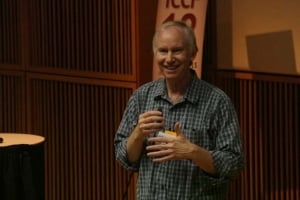 I also missed an impromptu Q&A with Peter Hagelstein, but luckily Eli got that on video, too.
I also missed an impromptu Q&A with Peter Hagelstein, but luckily Eli got that on video, too.
It was a special session that re-iterated Hagelstein’s excitement with his new model. He answered all questions, explaining further how this model can fit the Karabut data, and appears to correlate with Vysotskii’s, too.
One thing I didn’t miss was the Banquet in the evening.
Edmund Storms opened the dinner discussing the ISCMNS, and how easy it was to join, before Jean-Paul Biberian took over as MC.

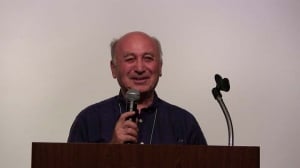
John Dash received the award for Best Poster.
Michael McKubre announced that ICCF-19 will be held in Venice, Italy March 15-21, 2015.
Frank Gordon announced the winner of the Preparata Metal.
Winner Pam Mosier-Boss accepts the Preparata Metal for her outstanding achievements in science.
The evening continued with ragtime musicians setting a down-home tone, and the available scientists who attended the very first ICCF-1 meeting in Salt Lake City, Utah assembled for a photo. Edmund Storms was there, but somehow disappeared right before the photo was taken.
There’s more coverage from the banquet to publish, but it’s been another 16 hour day, so for for now it’s time to say good night. Tomorrow is the final day which will be a half day with more panels and the closing session.

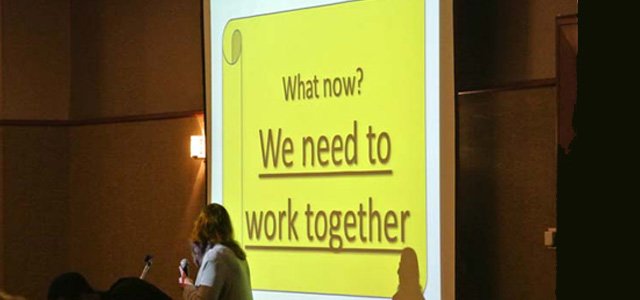

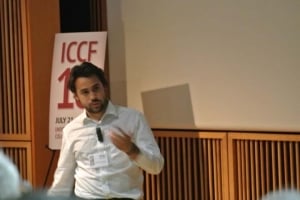
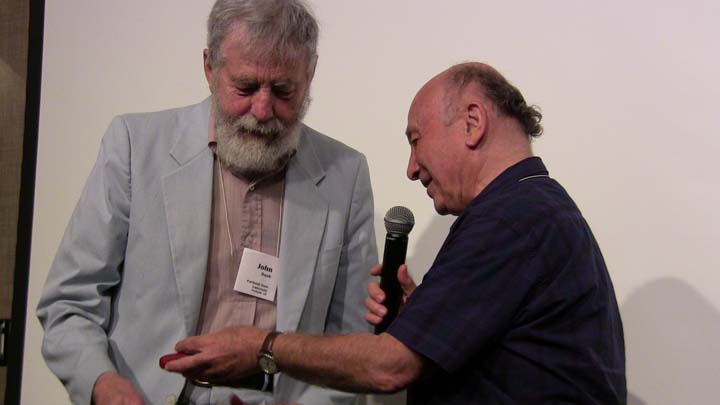
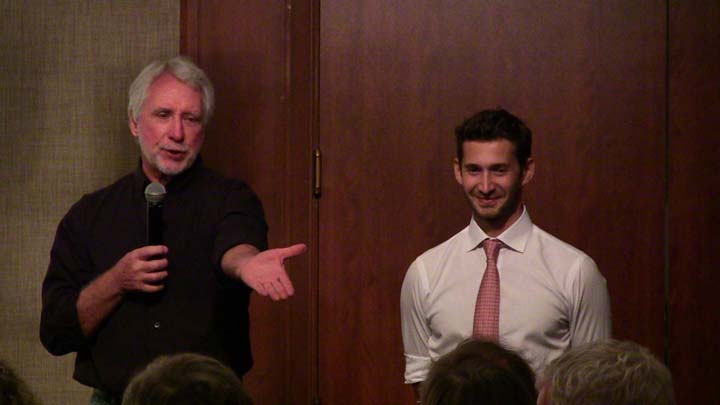
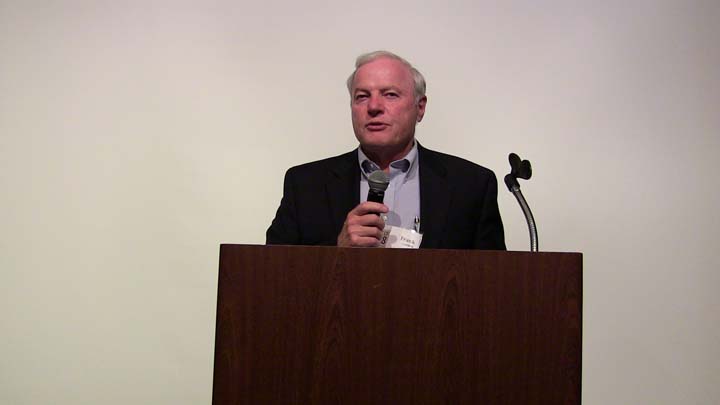

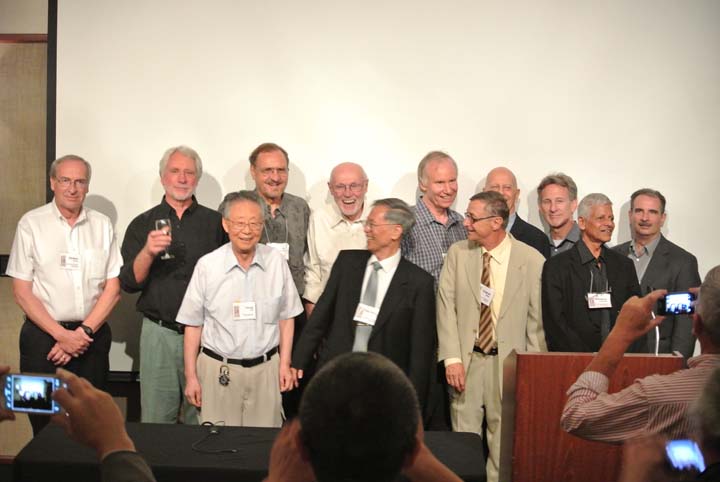
I’m so glad that Thomas Passell presented the evidence for deuteron stripping reactions. I think the reason why this mechanism was largely ignored in the early F&P days was because it rained on the parade. The precious metal palladium is being consumed as fuel. I think this may be a good example of cognitive dissonance. https://en.wikipedia.org/wiki/Cognitive_dissonance
Now that we have the fantastic hydrogen-nickel reactors up and running (the sun will burn out before we run out of nickel) we can relax and take a closer look at these Oppenheimer-Phillips reactions.
We finally made it!
http://www.youtube.com/watch?v=GhbzCgS5EAo
By the way, John Dash was the first person to see silver-109 being formed in F&P type reactions. http://lenr-canr.org/acrobat/DashJcoldfusion.pdf
Where is Asimov when you need him? That was some heavy physics. I had to refer to the net several times to get a vague grasp of the concepts.
My interpretation, for what it is worth is that Hagelstein, Vysotskii and Kim believe that they have the theory buttoned up. Time will tell.
Takahashi is predicting results.
It seems that ICCF 18 was dominated by the Theorists and Defkalion.
The ball is now in the empiricists court. How can the equations be tweeked to produce unsubtle results?
Well done Ruby.
Stripping and Tunneling GEC
The research for this quote from GEC is approximately from the years 2000 through 2007.
“Q. How do you overcome the coulomb barrier?
A. Several possibilities such as a stripping reaction or the equivalent to “tunneling” in solid state electronics have been suggested as a way to overcome the coulomb barrier. More research is needed to determine the answer to this question.
The DOE panel and others (at times certainly at certain other parties bequest) have screamed and discredited early cold fusioneers with the cry, “It does not fit known theory. It is impossible according to known theory. No way it doesn’t fit theory” etc etc etc…
GEC is not bothered by this.
Quote GEC
Q. How can this be real since it doesn’t match theory?
A. History is full of examples where the accepted theory had to be adapted to match new experimental results. At one time, theory held that the earth was flat. Galileo was put under house arrest by the church for observing that the earth was not the center of the universe. Cassini and other scientists held that the speed of light was infinite long after Romer had provided solid experimental evidence that it was 186,000 miles per second. There’s a statement in science that, “Theory guides, experiment decides.” A theory is only as good as its ability to predict or describe experimental results. If the experimental results don’t confirm the theory, it’s the theory that must change since the experimental results are controlled by nature. This is not to say that all current nuclear physics theories are wrong but that they are incomplete when it comes to explaining our experimental results. Each year, hundreds of PhD’s are awarded to students who have improved or evolved a theory so that it more accurately explains experimental results. These and many other examples show how theory must evolve to match observation. Several theories have been proposed but to date, none match all of our observed experimental results.
Nor the discrediting cry… If it was a nuclear reaction you would be dead.
GEC as the voice for the DOE’s early understanding of this research and experiment protocol.
Quote GEC “In it for the past 22 years.”
Q. If this is real, you should all be dead because of the neutrons that would have been produced. How do you answer that since you’re obviously still alive?
A. One of the properties of our experiments is that the neutron flux is several orders of magnitude less than that predicted by conventional theory. The current flux levels are not hazardous however we are currently working to optimize the experiments to increase the flux. We recognize the dangers of high-energy neutrons and take appropriate precautions.
Thanks for keeping us up to date on the conference!
Do you know if the lectures are recorded and will they be made available online?
We videod the lectures, and gave a copy to the ICCF crew. We can post up video if we have permission from the presenter. Unfortunately, there will be no time for editing the videos in my schedule, and I hope that the ICCF people find some money to do the editing. It was 5 days of 10-12 hours a day. it would have been nice to have a live link, and a crew editing on the fly.
Two things. You quote Kim as saying Defkalion uses deuterium. They never mentioned that before. Do they? He also said Defkalion will work with National Instruments. What does NI say about it? I remember when Rossi claimed to work with them, they categorically denied it. They only talked to him about selling him measuring equipment. Has anyone asked NI about Defkalion?
about deuretrium, Defkalion use 1Hydrogen for their ractor. maybe they made experiments with 2D?
Kim talk of deuterium since it was the old-school prefered actor , and his theory tryed to explai PdD reaction, producing He4 .
Ni last year invited Defkalion for panel and poster session. Defkalion is proud to show they use labview.
Truchard seems to be one of those free-mind who understood that the ban against cold fusion was unfounded, and as soon as he see that it was becoming commercial, he asked his big science boss to talk of cold fusion… that is my interpretation of what happen.
Kim originally formulated his theory for Pd-D systems, but now he has extended it to include metal-hydrides like Ni-H. Defkalion uses light-hydrogen H.
I was looking for Alberto Carpinteri presentation information, but I just noticed that you will include it later. There is no question that it is a blizzard, even an avalanche of exciting information. Many thanks for your fine coverage. I have particularly enjoyed seeing the casual, comfortable images of participants in an obviously relaxed, positive, state of mind. It seems that there is much about which to be optimistic.
I apologize for missing some lectures. We didn’t know we’d be videoing the whole lecture portion, and that made it a bit hectic.
I was only able to do half the interviews I wanted. But I’m glad we got the lectures for posterity.
Hi Ruby:
Thanks for all your hard work.
Hope you can take some time to chill out.
Thank you for the lead on the Oppenheimer-Phillips process Alan.
http://en.wikipedia.org/wiki/Oppenheimer%E2%80%93Phillips_process
So this was known in 1935?
I have to assume that the august body of physicists that caned P & F knew about it, therefore I conclude that their emphasis on the inpenetrability of the Coulomb barrier was disingenuous.
Edit:
Thinking about an atom in a strong electric field of the P & F cell, surely the electron cloud would have been distorted one way, and the proton of the deuteron would be distorted the other. This might have aided the neutrons penetration and the expulsion of the proton. I realize that I am thinking along classical (non quantum) lines.
Yeah Arthur, it was the first thing I thought about in April of 1989 (my one sentence letter to C&E News, May 15, 1989 C&EN page 3) when I read that they didn’t see any neutrons. The deuterons are farther apart in the palladium lattice than they are in molecular deuterium. Admittedly, there’s a bigger Coulomb barrier between palladium and a deuteron than there is between a deuteron and another deuteron but this isn’t taking place in a plasma. It’s taking place in a lattice. Although the deuteron is being repelled by a palladium nucleus it can’t retreat too far because it’s being pushed back by other palladium nuclei (it’s being braced). The conduction band electrons also provide shielding.
Oh, one last thing. The palladium nuclei have much larger thermal neutron cross-sections than a deuteron. So, they would present a bigger target to the neutron than another deuteron would.
You could be right Arthur. There’s another metal that could undergo an O-P reaction. See the video I posted on Ben’s old website.
http://e-catsite.com/2012/06/01/ike-was-right/
Thank you Allen. We were getting 4-5 hours of sleep and all day in the auditorium. I really could use some spa treatment! Now I will begin driving back to Eureka tomorrow.
But it was alot of fun, and very exciting to be around all that brain power. More than I could understand….
And THANK YOU Arthur, I am so grateful for ALL you’ve done.
You’ve made a huge difference with your support and encouragement.
LOVE LOVE LOVE
Go get some sleep Ruby.
To cold fusion believers,
Please have a look at e-Cat Site the articles “Belgian LANR Patents”, “LANR by Coulomb Explosion” and
“Cold Fusion Catalyst”. Thanks.
Here’s the link to the pdf of Thomas Passell’s presentation. My favorite topic: Stripping reactions. https://mospace.umsystem.edu/xmlui/bitstream/handle/10355/36832/EvidenceDeuteronStrippingMetals.pdf?sequence=1
See where he crunches the numbers for deuterium-titanium stripping reactions. Keep in mind that ITER needs lithium to make tritium. Will we run out of lithium before we run out of titanium? Would energy production based on deuterium-titanium stripping reactions be an alternative to ITER?